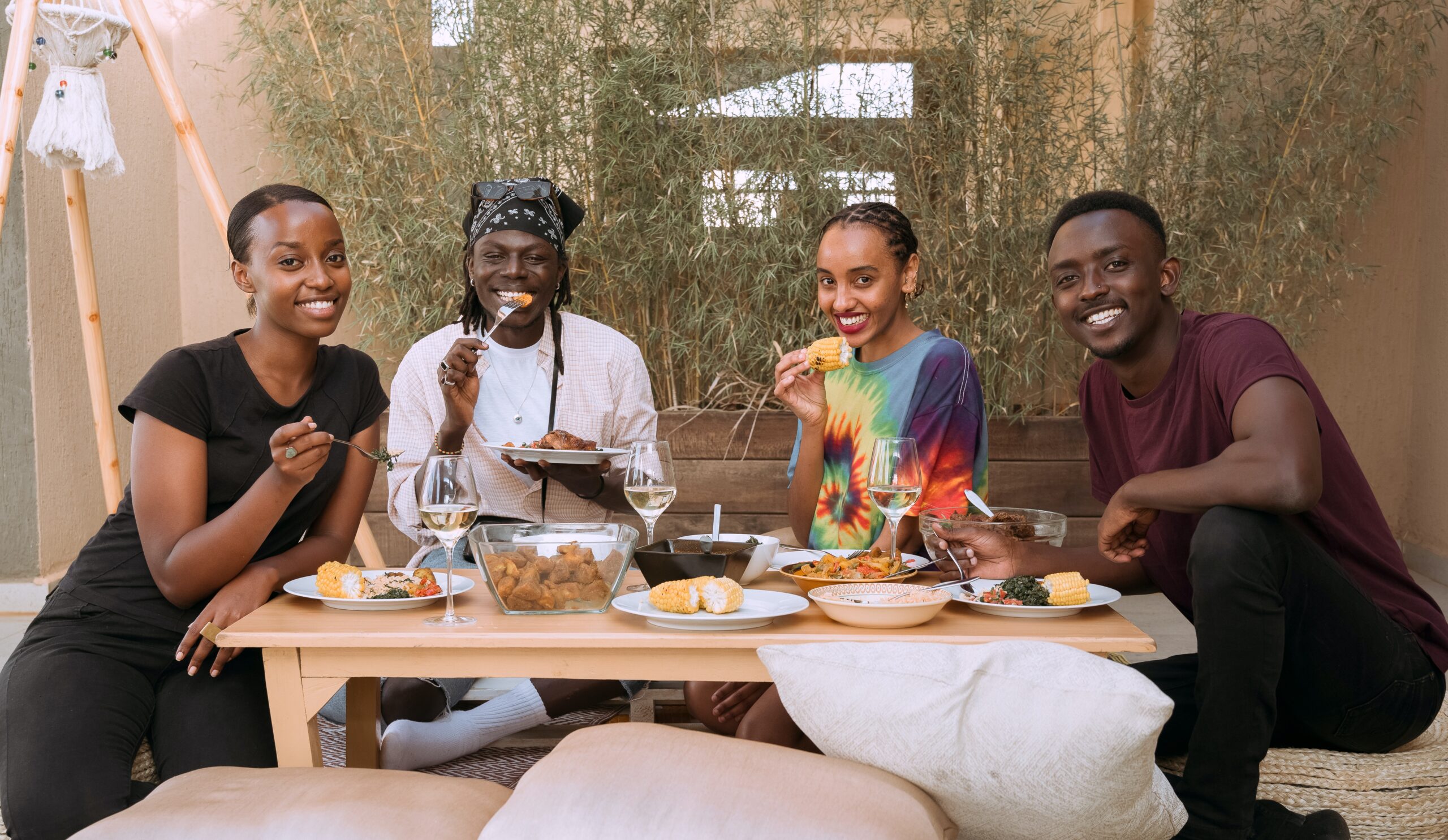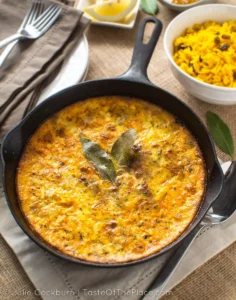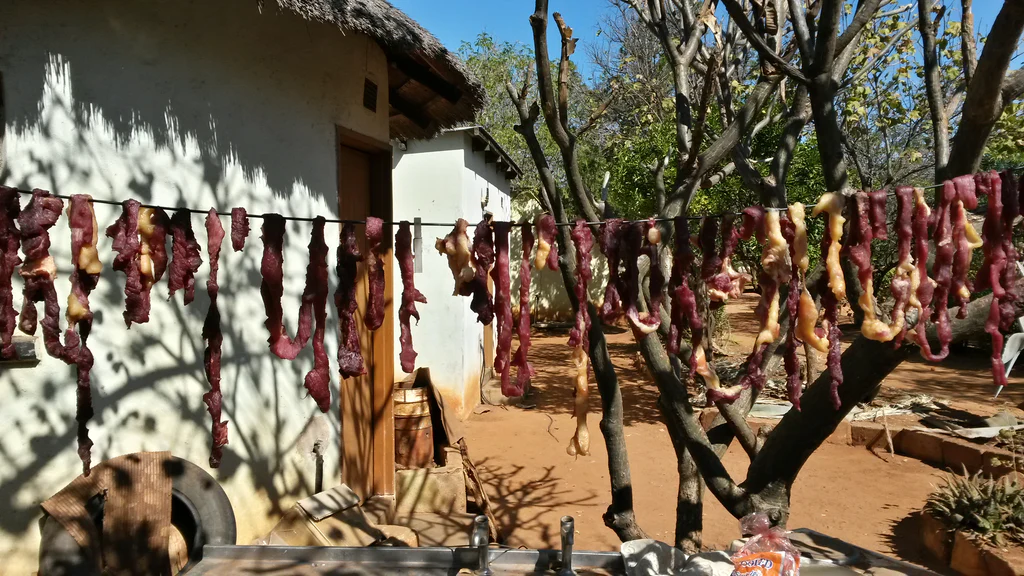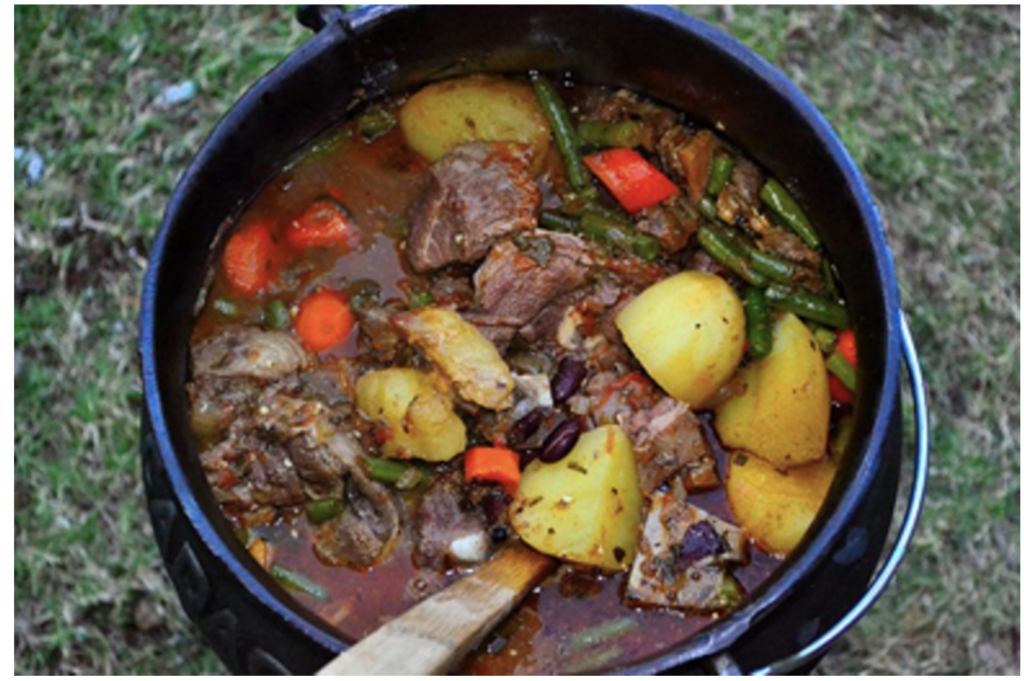
South Africa is a country with a rich and diverse culinary heritage. Traditional dishes vary significantly across the country’s regions and are influenced by indigenous cultures and the Dutch, British, Indian, and Malay settlers. Many of these dishes have become integral to South African cuisine and are enjoyed by locals and tourists.
One of the most iconic South African dishes is the braai, a traditional barbecue enjoyed throughout the country. Meat, such as boerewors (sausage), steak, and lamb chops, is cooked over an open flame and served with sides such as pap (a type of porridge made from maize meal) and chakalaka (a spicy relish made from vegetables). Another popular dish is bobotie, a sweet and savory baked dish made with spiced minced meat, dried fruit, and a custard-like egg mixture.
Other traditional South African dishes include:
- Bredie (a slow-cooked stew made with meat and vegetables).
- Bunny chow (a hollowed-out loaf of bread filled with curry).
- Boerewors rolls (a type of hot dog made with Boerewors sausage).
These dishes are a testament to the country’s diverse cultural influences and must-try for anyone visiting South Africa.

Historical Context of South African Cuisine
South African cuisine has a rich and diverse history that reflects the country’s cultural heritage. The cuisine is a fusion of traditional African, European, and Asian influences, which has evolved over centuries due to the country’s history of colonization, slavery, and immigration.
Before the arrival of Europeans, the indigenous people of South Africa, such as the Khoisan and Bantu, had their unique cuisines based on the availability of local ingredients such as meat, vegetables, and grains. These ingredients were prepared using various cooking methods such as grilling, roasting, and boiling.
With the arrival of Europeans in the 17th century, new ingredients such as wheat, sugar, and spices were introduced to the country. The Dutch settlers, known as Boers, brought with them their cuisine, which included dishes such as bobotie (a dish made with spiced minced meat and topped with a custard-like topping), bredie (a stew made with beef and vegetables), and boerewors (a type of sausage).
During the 19th century, South Africa became a British colony, and British cuisine also influenced the country’s cuisine. The British introduced fish, chips, shepherd’s pie, and roast beef.
In the 20th century, South Africa experienced an influx of immigrants from Asia, particularly from India and Malaysia. These immigrants brought with them their cuisine, which included dishes such as curry, samosas, and roti.
Today, South African cuisine is a fusion of these various influences, characterized by its bold flavors, use of spices, and diverse ingredients. Some of the most popular dishes include biltong (a type of dried meat), boerewors, chakalaka (a spicy vegetable relish), and pap (a type of porridge made from maize).
Influence of Indigenous Cultures
South Africa is a diverse country with a rich cultural heritage reflected in its traditional cuisine. Indigenous cultures have played a significant role in shaping the country’s food culture, and their influence is evident in many dishes enjoyed today.
One of the most significant indigenous cultures in South Africa is the Zulu people. Their traditional dishes are characterized by the use of maize, which is a staple food in many parts of the country. One of the most famous Zulu dishes is pap, a porridge made from maize meal. It is often served with a tomato and onion relish, known as chakalaka, or with a meat or vegetable stew.
The Xhosa people are another indigenous culture that has significantly influenced South African cuisine. They are known for their love of umngqusho, a dish made from beans and maize. It is often served with meat, such as beef or chicken, and is a popular dish at traditional Xhosa gatherings.
The Khoisan people, who are the indigenous people of the Western Cape, have also had an impact on South African cuisine. They are known for their love of game meat, such as ostrich and springbok, which are still prevalent in many traditional dishes today.
In addition to these cultures, many other indigenous groups in South Africa have contributed to the country’s food culture. Each group has unique dishes and cooking techniques passed down from generation to generation.
Overall, the influence of indigenous cultures on South African cuisine is undeniable. Their traditional dishes have become an integral part of the country’s food culture and are enjoyed by people from all walks of life.
Notable Traditional Dishes
Bobotie
Bobotie is a dish from the Cape Malay community in South Africa. It is a baked dish with spiced minced meat, usually beef or lamb, mixed with raisins, chutney, and curry powder. The meat mixture is then topped with a custard made from eggs and milk and baked until golden brown. Bobotie is often served with yellow rice, which is rice that has been cooked with turmeric and raisins.

Boerewors

Boerewors is a type of sausage that is popular in South Africa. It is made from beef, pork, or lamb and is seasoned with coriander, cloves, and nutmeg. Boerewors are often served at braais, which are South African barbecues, and are usually eaten with a side of pap, a type of porridge made from maize meal.
Biltong

Biltong is a type of dried meat that is similar to beef jerky. It is usually made from beef or game meat, such as kudu or ostrich, and is seasoned with salt, pepper, and vinegar. Biltong is a popular snack in South Africa and is often eaten while watching sports or on road trips.
Potjiekos

Potjiekos is a traditional South African stew cooked in a cast-iron pot over an open fire. The fuss is made with meat, such as beef or lamb, and vegetables, such as potatoes, carrots, and onions. The dish is seasoned with cumin, coriander, and turmeric and is often served with pap or bread.
Overall, South Africa has a rich culinary heritage, and these traditional dishes are just a few examples of the delicious and unique foods that can be found in the country.
Regional Specialties
Cape Malay Cuisine

Cape Malay cuisine blends Malay, Indonesian, and African influences. It is characterized by using spices such as cinnamon, turmeric, and cardamom. A staple dish in Cape Malay cuisine is bobotie, a baked dish made with minced meat, herbs, and an egg-based topping. Other famous words include bredie, a beef and vegetable stew, and sosaties, skewered meat marinated in a sweet and sour sauce.
Zulu Cuisine

Zulu cuisine is known for its use of maize, beans, and vegetables. A popular dish is umngqusho, a stew made with sugar beans and maize. Another staple dish is sighed, a porridge made with maize meal and served with meat or vegetables. Zulu cuisine also features a range of meat dishes, including grilled beef, chicken, and lamb.
Afrikaans Cuisine
Afrikaans cuisine is a fusion of Dutch, German, and African influences. Biltong, a type of dried meat, is a popular snack in Afrikaans cuisine. Other popular dishes include potjiekos, a beef and vegetable stew cooked in a cast-iron pot over an open flame, and boerewors, a sausage made with beef and pork. Afrikaans cuisine also features a range of baked goods, including melktert, a sweet milk tart, and koeksisters, a doughnut dipped in syrup.
South Africa’s regional specialties offer a diverse range of flavors and ingredients. Whether you prefer spicy Cape Malay cuisine, hearty Zulu cuisine, or fusion Afrikaans cuisine, there is something for everyone to enjoy.
Preparation Techniques
South African traditional dishes are known for their unique blend of spices and flavors. To achieve the perfect taste and texture, following the proper preparation techniques is essential. Here are some standard methods used in South African cooking:
Braai (Barbecue)
Braai is a popular cooking technique in South Africa. It involves cooking meat over an open flame. The meat is usually marinated with a blend of spices and sauces to add flavor. Some of the most popular meats for braai include beef, lamb, and chicken. The heart is simmered to ensure it is tender and juicy.
Potjiekos (Stew)
Potjiekos is a traditional South African stew cooked in a cast-iron pot over an open flame. The dish is made with various meats, vegetables, and spices. The meat is usually browned first, and then the vegetables are added. The stew is then left to simmer for several hours to allow the flavors to blend.
Pap (Porridge)
Pap is a staple food in South Africa. It is made from ground maize and is similar to polenta. The maize meal is boiled with water to create a thick porridge. Pap can be served as a side dish or as a main meal with a meat stew.
Chakalaka (Vegetable Relish)
Chakalaka is a spicy vegetable relish commonly served with pap and braai meat. The dish has various vegetables, including onions, peppers, carrots, and tomatoes. The vegetables are cooked with a blend of spices and then left to simmer until they are soft and tender.
Bobotie (Meatloaf)
Bobotie is a traditional South African meatloaf made with ground beef or lamb. The meat is mixed with spices, bread crumbs, and milk to create a moist and flavorful dish. The beef is topped with an egg custard and baked in the oven until golden brown.
South African traditional dishes are known for their unique flavors and cooking techniques. You can create delicious and authentic South African dishes in your kitchen using proper preparation techniques.
Traditional Cooking Utensils
South African cuisine is rich in flavor and culture; traditional cooking utensils are vital in many dishes. Here are some of the most commonly used knives in South African kitchens:
- Potjie Pot: This three-legged cast-iron pot is a staple in South African cooking. It’s perfect for slow-cooking stews, curries, and soups over an open fire.
- Braai Grid: A braai grid is a metal grid grilling meat over an open fire. It’s a popular way of cooking meat in South Africa and is often accompanied by various side dishes.
- Mortar and Pestle: A mortar and pestle are used to grind spices and herbs, such as coriander, cumin, and chili peppers, to make flavorful spice blends.
- Ukhamba: This traditional clay pot is used to ferment maize meal, a staple food in South Africa. The fermented maize meal is known as “umphokoqo” and is often served with meat and vegetables.
- Potato Ricer: A potato ricer is used to mash potatoes and other root vegetables, such as sweet potatoes and carrots. It produces a smooth and fluffy texture perfect for dishes like “pap en sous.”
- Biltong Slicer: Biltong is a popular dried meat snack in South Africa, and a biltong slicer is used to slice the meat thinly. It’s perfect for snacking or adding to dishes like “potjiekos.”
These traditional cooking utensils are not only functional but also represent the rich cultural heritage of South Africa.
Influence on Global Cuisine
South Africa’s traditional dishes have been gaining popularity worldwide due to their unique blend of flavors and ingredients. The country’s diverse cultural heritage has contributed to developing a rich culinary tradition influencing global cuisine.
One of the most well-known South African dishes is the “braai,” a type of barbecue that is traditionally made with meat such as boerewors (sausage) and sosaties (kebabs). The braai has become popular in other countries, with many people enjoying the smoky flavor of the grilled meat.
Another famous South African dish is “bobotie,” a savory pie made with minced meat, curry powder, and sultanas. Bobotie has been described as a fusion of Indian and Cape Malay flavors and has become a favorite in many countries.
South Africa’s love of spices has also influenced global cuisine, with many chefs incorporating traditional South African spices such as peri-peri, masala, and chutney. These spices add a unique flavor to traditional dishes and have become popular in many countries.
South Africa’s traditional cuisine uses indigenous ingredients such as rooibos tea, biltong (dried meat), and amasi (sour milk). These ingredients have become popular in other countries, with many people enjoying the unique taste and health benefits.
Overall, South Africa’s traditional dishes have significantly influenced global cuisine. The country’s diverse cultural heritage has contributed to developing a rich culinary tradition that has become popular worldwide.
Conclusion
South Africa’s traditional cuisine reflects the country’s diverse cultural heritage. Blending indigenous African, European, and Asian flavors has resulted in a unique culinary experience rich in history and flavor.
From the savory meat dishes of the Zulu and Xhosa tribes to the spicy curries of the Indian community, South Africa’s traditional dishes are a feast for the senses. Using fresh, locally sourced ingredients and various spices and herbs adds depth and complexity to each dish.
Some of the most famous traditional dishes include:
- Bobotie: A fragrant, spiced meat dish with a creamy, egg-based topping.
- Bunny Chow: A hollowed-out loaf of bread filled with spicy curry.
- Pap and Wors: A staple dish made from maize meal and grilled sausage.
- Biltong: A dried meat snack that is similar to beef jerky.
In addition to these dishes, South Africa is also known for its braai culture. A braai is a traditional barbecue that grills meat over an open flame. It is a social event that brings together family and friends and is a beloved pastime in South Africa.
Overall, South Africa’s traditional cuisine is a testament to the country’s rich cultural heritage and culinary traditions. Whether you’re a foodie looking to explore new flavors or a traveler looking to experience the local culture, South Africa’s traditional dishes are to be noticed.
Leave a Reply